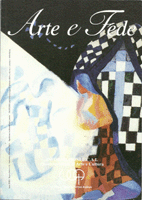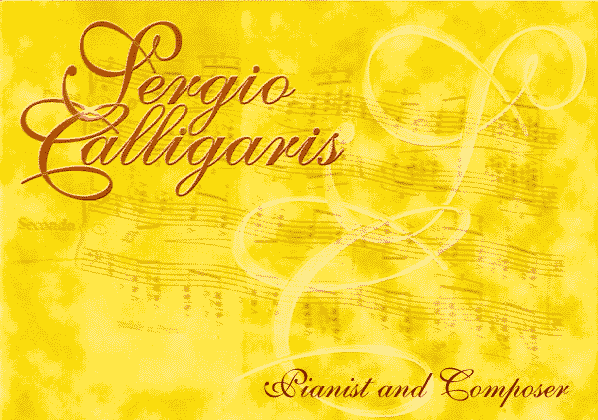 Arte e Fede, Year
XXIII - Nr 42
Arte e Fede, Year
XXIII - Nr 42
(INFORMAZIONI UCAI - 4Mon.magazine of Art and Culture)
September - December 2011 (page 51):
INTERVIEW TO THE RENOWNED COMPOSER SERGIO CALLIGARIS
That's not true.
Classical music
is not for a few privileged
by Alessandra Pompili
Among contemporary composers, Sergio Calligaris is one whose works feature prominently
in concert-halls. Pieces such as the Quaderno Pianistico di Renzo op. 7 for piano solo or
the Due Danze Concertanti op. 22 and the Scene Coreografiche op. 30 (for four-hand piano
or two pianos) have been part of the musicians’ standard repertoire for years, and
carry on being proposed by broadcasters across the world. The encounter between
Calligaris’ music and his interpreters has always been a fruitful and happy one;
however, is it perhaps worthier of notice that his music meets with equal success with
audiences. Perhaps a reason could be sought in the fact that, although being atonal,
Calligaris’ compositions are alien to experimental solutions (instruments are never
prepared, the chamber ensembles are traditional without being obvious, structure is always
respected).
Since the aim of this interview is to offer an overview of four compositions (Ave Maria
op. 8, Requiem op. 17, Ave Verum op. 42, Panis Angelicus op. 47) that have punctuated, in
different ways, Calligaris’ crucial relationship with the Catholic faith, we will
leave to the Maestro the task of highlighting both his compositional process and the
relevance that sacred music has for him. What is important to underline, at the very
beginning, is that the tight link between inspiration as a response to life’s events
and compositional structure is perhaps the most fascinating aspect to be found in
Calligaris’ sacred works.
Maestro, would you like to outline the most important characteristics of your sacred
works?
I would single out, as a pre-compositional feature, the relation with patronage and
liturgical service. Both aspects are alien to my sacred works: the former, because all
four compositions stem from a definite inspiration, the latter since they are not
conceived to support a religious service.
Some events had, in my life, such a resonance to urge me to express my feelings through
music - this is so true that some structural details in my compositions are highlighted by
those particular events. Two examples will suffice to explain this. The inspiration for
the Requiem op. 17 came from my mother’s departure, which was an heartbreaking event.
Thus the Requiem is a work of powerful dramatic contrasts requiring, from the musicians, a
complete and almost virtuosic mastery of their instrument. Amidst such turmoil, however,
we witness the rising of the peaceful and translucent final movement “In
Paradisum”: a closing that may appear unusual to many a listener but is of a striking
meaning to me. Similarly to the Requiem written by Gabriel Fauré, which was also composed
in memory of his mother and features a consoling end, “In Paradisum” conveys the
desire for my mother’s peace and tranquillity. The same principle is to be found in
the Ave Verum op. 42, written in memory of the untimely departure of a couple of
friends’ son: the final stanza, with the Benedictus, is a mystic adagio wishing for
the serenity of the eternal rest. The incorporeal atmosphere of the finale of the Ave
Verum is recalled, but with a different slant, in that of the Panis Angelicus. The latter
is dedicated to “His Holiness Benedict the XVI with devoted esteem in the year of the
Eucharist 2005” and here, for the first time in the history of the genre, the second
stanza of the hymn (“Te trina Deitas / unaque poscimus....” ) is also set in
music. The stanza closes with a prayer to the Holy Trinity to lead us ad lucem quam
inhabitas, i.e. to the light that has no end. I felt the power of such invocation so
intensely that I wrote the finale before everything else! Finally, the Ave Maria op. 8 was
initially conceived at the same time as the Quaderno Pianistico di Renzo but then I
decided to publish it separately. This is inspired to the image of Mary as found in the
church of Santa Maria delle Fratte in Rome. The writing here wishes to recall the
translucent purity of that painting and is build upon a melody inserted in the middle
register and surrounded by dainty harmonies. This is also the only example in my catalogue
(comprising religious and non-religious compositions) where the superimposition between
melody and harmony is not present: the Ave Maria is developed on alternate notes. To sum
up, the structure and texture of my sacred works have a profound relationship with my
inspiration and, conversely, with the events underpinning it.
As for their relation with worship, my works are not strictly complementary to it. Of
course they can be used within a ritual, but they have not been thought of as functional.
A more complicated aspect relates to the complexity of my compositions, which requires
excellent professional musicians. I must also confess, though I will touch upon the
subject later, that my own relationship with contemporary liturgical music is not
particularly easy.
After outlining some structural features, could you introduce us to details relating
to the harmonic design?
Whilst my inspiration has to do with an inner response, the compositional structure is
the result of a highly intellectual process. As for me, the harmonic succession always
precedes the formulation of the melody, so that the former is never a mere support of the
latter but lives in an autonomous relationship. Chord progressions are characterised by
their unique phrasing and unique genesis: we can almost say that chords are like bridges
or planets around which satellites orbit. They are not born in isolation but spring one
from another according to a rigorous succession.
In relation to harmony, I have a fondness for forms hinging on sequences of chords of
fourths (almost a development of Aleksandr Skrjabin’s mystic chord), for their
capability to produce the feeling of an almost iridescent tonality. The polyphonic
sections of my compositions are thus decidedly atonal, but the counterpoint hinges on a
structure of quartal harmony - and this helps listeners avoiding the feeling of being lost
in a chaos without landmarks. The audience also appears to appreciate the sense of
security deriving from the logic of progression. In this sense, structures are not an
ornament but the conditions of possibility for a fruitful and sympathetic communication
between composer and listeners.
All your works have been for various ensembles. Why are there so many versions of
the same composition?
This is logical outcome of the compositional process. Since the instrumental parts are
the depository of the harmonies and as such are complete in themselves, they can live
autonomously from the vocal part. I never deal with the instruments as if they were mere
accompaniments to the voice, instead as independent entities; this is why all my sacred
works can be performed without the vocal part. On the other hand, this does not mean that
the voice performs a subordinate role: it remains, of course, of paramount importance but
is conceived a sort of continuous counter-subject within the independent harmonic
structure. We could compare it to a recitar cantando suggestive to Richard Wagner’s
counter-point treatment.
This should make clear why there is an Ave Maria op. 8 for voice and piano and a version
8a for piano solo; of the Requiem op. 17 (for soloists, choir, two pianos and four
timpani) there exist a version published as Suite da Requiem no. 1 op. 17a for violin,
horn and piano and a third one published as Suite op. 43 for two pianos and four timpani
ad libitum (so much so that the duo Gioiosa-Ossipova performed it without timpani). Of the
Ave Verum op. 42 I wrote a version for mixed choir (or vocal quartet ad libitum) and piano
and a version op. 42a for piano solo. Finally between 2005 and 2008 I developed four
different versions of the Panis Angelicus. Listening to any such versions reveals that
there is no impoverishment of one compared to the others: the example of the Ave Maria
should suffice to prove it. The three versions available are for tenor (Ennio Buoso) and
piano (Giorgio Favaretto) as published by Classico Records; for three sopranos (Doriana
Giuliodoro, Silvia Marcellini e Cristiana Cecchi) and piano (Marco Sollini) and for piano
solo (my own interpretation) - the latter two are found in the CD Armonie della Sera.
At the end of our conversation, could I ask for your opinion about the future of
sacred music?
Sacred music would enjoy a bright future if audiences were provided with the necessary
tools to appreciate it fully. I think first and foremost to the the education of
musicians; an education that should be solid and well-grounded. Whereas we cannot have
Ludwig van Beethoven’s Missa Solemnis performed at every liturgy, so it is
unconceivable that the musical side of a service has to be left to a couple of shabby
guitars as sometimes still happens. This is a usage that does not add anything to the
depth of the liturgy but impoverishes it. The composer too has a crucial responsibility:
his role is to propose models characterised by both rigorous structure and adherence to
the sacred texts.
Let me say then, at the end, that it is simply not true that the destiny of classical
music is to be a niche for a few privileged ones. When Maestro Gianluigi Gelmetti
performed Richard Wagner’s Tristan und Isolde (a work lasting almost six hours) in
front of an audience made by high-school students only, someone might have foreseen the
en-mass evacuation of the hall. I was present to that wonderful event and can testify not
only that nobody moved from his seat, but most of all that the acclamation at the end of
the opera was as rapturous as that of a stadium. The music is overwhelming, the performing
was passionate and the students responded with corresponding enthusiasm. Perhaps this
would be necessary to ensure a bright future to sacred music: overwhelming music and
passionate musicians. The response of the audience would then certainly meet all
expectations.
(English text entirely written by the Author)
Alessandra Pompili
Concert pianist interested both in the little-known classical and the contemporary
repertoire, with special attention to sacred compositions for piano solo. Since 2006
Alessandra co-operates with Vatican Radio as a soloist and freelance producer of music
programmes for Studio A (for example, the seven episodes about Franz Liszt broadcast
between 2009 and 2010). Alessandra lives between Rome, her native city, and Manchester
(England), where she teaches at the School of Art Histories and Cultures of the
University.

